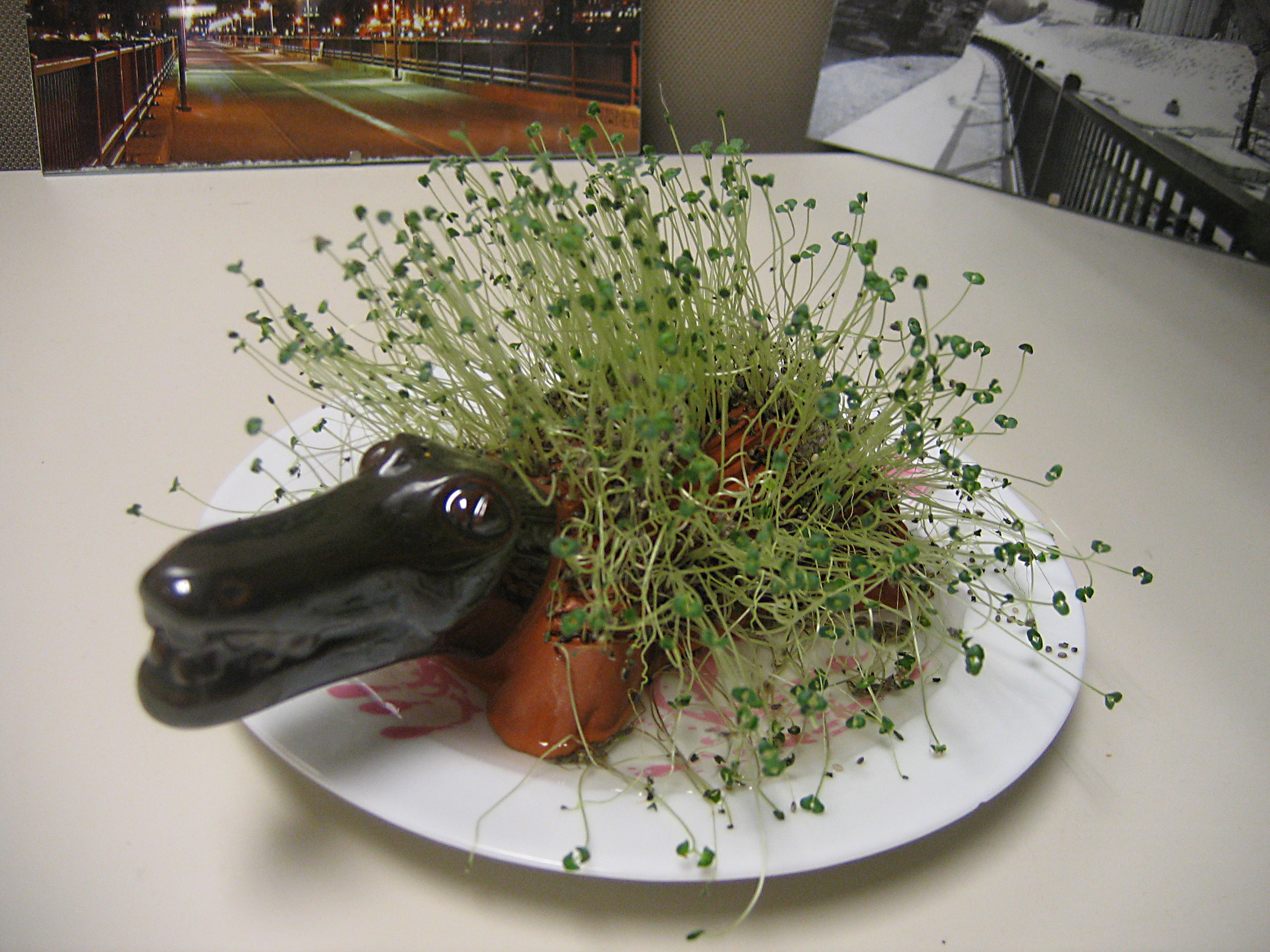
Ch-ch-ch-chia! Lately, eating chia seeds has been all the rage. But for those of us of a certain age, all we knew about them was Chia Pets (as seen on TV). Slightly more fun than a Pet Rock (perhaps), a Chia Pet is a terra cotta shape that you soak in water and slather in chia seeds. When the seeds sprout, your Chia Pet grows fur. (I don’t know what the deal is with the alligator. Who ever heard of a furry alligator?)
It never occurred to me that you could eat the chia seeds – it would have been like suggesting you could eat Sea Monkeys.
Flash forward a few decades, and suddenly the health food crowd is eating chia seeds (Salvia hispanica).

Touted as a “super food” by some, chia seeds are relatively high in protein and omega-3 and omega-6 fatty acids. Many claims have been made regarding possible health benefits of chia seeds but, since this blog is for informational purposes only and I am not a healthcare professional, I leave it to you to do your own research and due diligence.
This article provides an overview, and is a good place to start.
Not much scientific health research has been done on chia seeds yet. However, according to one journal article, “the historical use of Salvia hispanica suggests that it is safe for consumption by nonallergic individuals. Further rigorous examination is warranted pertaining to the use of Salvia hispanica as a dietary supplement, as well as in the treatment or prevention of human disease.”
If you are skeptical about the health claims being put forth in the popular media about chia seeds, and you want more scientific information, this blog post is just the thing for you.
My Experience: I read that chia seeds grew slimy* when they were reconstituting, and I thought the texture might be gag-inducing off-putting. (*Apparently the less unappetizing adjective is “gelatinous”.)

In fact, “Chia seeds have the ability to absorb up to 27 times their weight in water,” according to Dr. Rebecca Rawl, from Carolinas Medical Center in Charlotte, N.C.
The articles I read suggested that the easiest way to start eating chia seeds was to mix the chia seeds into something where they could absorb moisture but the texture wouldn’t be noticeable, like yogurt. So that is how I began eating chia seeds – mixed into yogurt.
To me, chia seeds don’t have a noticeable flavor. But if they haven’t fully reconstituted they are a bit crunchy, which is fine, as long as you’re expecting it (yogurt, for example, doesn’t typically crunch). So, if you want them to get good and slimy gelatinous, you have to give them a few minutes to soak up moisture from whatever you’ve mixed them into (or pre-mix them with water).
I currently mix them into a 6 ounce glass of low-sodium V-8 juice (which I season with Tabasco sauce), and wait for them to reconstitute before I drink it. [Stir well – they tend to clump on the bottom of the glass!]
I have found that I don’t mind the consistency of the reconstituted chia seeds – it reminds me of tapioca pearls. But a few always get caught in my teeth at the gum line. So check your teeth before you leave the house…
“Why are you eating this slimy, disgusting seed?,” you might ask.
Good question.
To put it delicately, chia seeds help keep you regular.
Chia seeds are high in fiber*, and the gelatinous coating around the seeds helps them ease through your digestive system. *“Just 1 tablespoon of chia seeds will give you 19% of your recommended daily fiber.” It also helps your stool to be “fluffier,” if that makes any sense to you.
“Chia seeds are a good source of insoluble fiber. The seeds expand quite a bit and form a gel when they come into contact with water. This gel adds bulk to your stool, which keeps bowel movements regular and helps prevent constipation.”
Certain medications, like iron supplements or opioid painkillers, cause constipation as a side effect. Eating chia seeds helps counteract that effect. Instead of getting dense and compacted, your stool stays more liquid and continues to move through your system.
It’s up to you whether you decide to take them daily, as preventative maintenance for your digestive system, or whether you choose to use them on an “as needed” basis. They do seem to act relatively quickly, so you don’t have to wait days for the effects.
If you happen to keep an eye on your stool, you can make adjustments as necessary.
“Bottom” line: Many health claims have been made about the benefits of eating chia seeds. Most of them have not been substantiated by scientific research (although much research remains to be done). I use chia seeds as a natural means of maintaining regular bowel movements. They contain only one ingredient, they’re easy to add to my regular diet, and they counteract the constipating effects of some prescription medicines and supplements.
But chia seeds are not for everyone. See cautions below.
CAUTION: WebMD lists several possible side effects of consuming chia seeds. If you have one of these conditions, consult with your health care provider before consuming large or frequent quantities of chia seeds.
CAUTION: Some people are allergic to chia seeds. These individuals should not consume chia seeds. If you are allergic to sesame seeds or mustard seeds, you may also be allergic to chia seeds.
CAUTION: Although you can eat chia seeds wet or dry, it is not recommended that you eat a bunch of dry chia seeds and then drink a glass of water. If you do this, it is possible to have problems with chia seeds lodging in your throat. People with a history of swallowing problems or esophageal strictures are cautioned to only eat chia seeds after the seeds have fully expanded (same source as previous link).
CAUTION: It is recommended that you not consume more than 3 tablespoons of chia seeds at a time, as this can cause you to visit the bathroom more frequently than you might desire. According to one source, the recommended dose for children ages 4 1/2 – 18 is 1 tablespoon per day, although research has not yet established optimal or maximum doses for any age.
NOTE: For an overview of scientific research conducted on the health benefits/side effects of chia seeds, see here.
NOTE: Nowhere have I found clarification as to whether the suggested doses (in tablespoons) refers to the dry seeds or the reconstituted (wet) seeds. I measure approximately 1 1/2 tablespoons of dry seeds into my food or drink and wait for them to reconstitute before consuming them.
